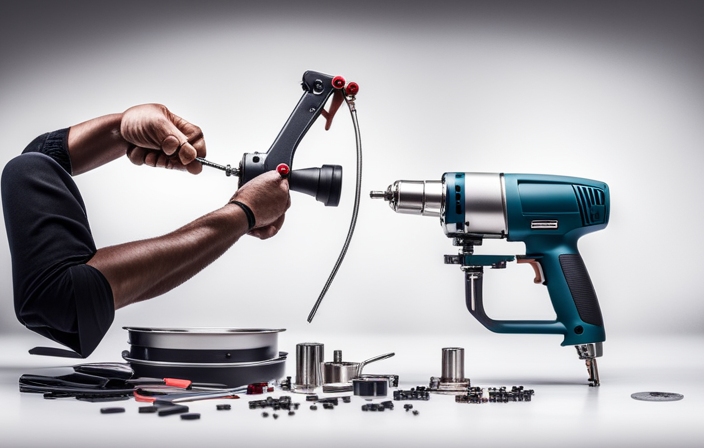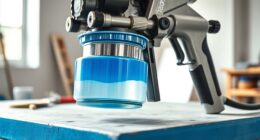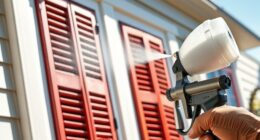Painting a house with vinyl siding may appear daunting at first, but with the right tools and techniques, it can become a rewarding and transformative experience. Imagine the chance to revitalize your home’s look, enhance its curb appeal, and increase its value.
In this article, I will guide you through the process of painting your vinyl sided house using an airless sprayer. This method allows for a smooth and even application, ensuring a professional-looking finish. I will walk you through the steps of:
- Preparing the surface
- Gathering the necessary materials
- Setting up and testing the airless sprayer
- Painting your house
I will also provide tips on applying multiple coats, considering professional help, and maintaining the painted surface for long-lasting results.
So let’s get started and give your vinyl sided house the makeover it deserves!
Key Takeaways
- Painting a vinyl sided house with an airless sprayer can provide a fresh look, enhanced curb appeal, and increased value.
- The process involves preparing the surface, gathering materials, setting up the sprayer, and painting with long, even strokes.
- Applying multiple thin coats is important for a smooth and even finish, and professional help should be considered for a flawless outcome.
- It is crucial to clean and maintain the airless sprayer after each use, following the manufacturer’s instructions, to ensure a professional-looking paint job and long-lasting beauty and protection.
Prepare the Surface of Your Vinyl Sided House
Now that you’ve chosen to spruce up your vinyl-sided house, it’s time to roll up your sleeves and get ready to prepare the surface for a flawless paint job. Maintaining your vinyl siding is crucial to ensure a long-lasting and beautiful finish.
Before diving into painting, it’s important to inspect the siding for any cracks, peeling paint, or signs of damage. If you come across any issues, make sure to address them before proceeding. Additionally, consider alternative painting methods such as power washing or using a vinyl-safe cleaner to remove dirt and debris from the surface. This will ensure proper adhesion of the paint.
Once the surface is clean and in good condition, you can move on to gathering the necessary materials and equipment for the painting process.
Gather the Necessary Materials and Equipment
First, make sure you’ve got all the tools and gear you need to tackle this project. When choosing the right paint color for your vinyl sided house, consider the overall aesthetic and style you want to achieve. It’s important to select a paint color that not only enhances the appearance of your house but also complements the surrounding environment.
Additionally, ensure that you take safety precautions while using an airless sprayer. Wear protective clothing, such as goggles, gloves, and a respirator mask, to protect yourself from paint fumes and potential overspray. It’s also important to work in a well-ventilated area and cover nearby plants, windows, and any other surfaces that you don’t want to be painted.
With all your materials and safety measures in place, you’re ready to move on to the next section about setting up and testing your airless sprayer.
Set Up and Test Your Airless Sprayer
Before starting to paint, it’s crucial to familiarize myself with the instruction manual of the airless sprayer. This will ensure that I understand all the features and functions of the sprayer and can use it correctly.
Once I’ve read the manual, I’ll set up the sprayer according to the manufacturer’s guidelines. I’ll make sure to attach the necessary hoses and adjust the pressure settings.
Finally, I’ll test the sprayer on a scrap surface to ensure that it’s working properly and that the paint is being applied evenly.
Read the Instruction Manual
To get started, it’s crucial to read the instruction manual before painting a vinyl sided house with an airless sprayer. The manual provides valuable information on how to properly operate and troubleshoot the sprayer. Here are some helpful tips for troubleshooting airless sprayer issues:
| Issue | Solution |
|---|---|
| Clogged nozzle | Clean the nozzle using a nozzle cleaning tool or replace it if necessary. |
| Inconsistent spray pattern | Check the paint viscosity and adjust the pressure accordingly. Also, ensure the sprayer tip is clean and properly aligned. |
| Motor not starting | Check the power source and make sure the sprayer is properly plugged in. Also, check if the motor is overheated and allow it to cool down if needed. |
It’s important to avoid common mistakes when using an airless sprayer, such as applying too much pressure, not properly cleaning the sprayer after use, or using the wrong type of paint. By familiarizing yourself with the instruction manual, you’ll be equipped to set up the sprayer correctly and achieve optimal results.
Set Up the Sprayer Correctly
Once you’ve familiarized yourself with the instruction manual, make sure you’ve correctly set up the sprayer for optimal results.
The first step is to choose the proper nozzle for your project. Different nozzle sizes produce different spray patterns and flow rates, so it’s important to select the one that best suits your needs. Additionally, pay attention to the manufacturer’s recommendations for the type of paint you’re using.
To avoid common sprayer issues, such as clogging or uneven spray, make sure the sprayer is clean and free of debris before starting. Check the filters and unclog any blockages. Adjust the pressure according to the paint viscosity and the desired finish.
To ensure everything is functioning smoothly, it’s always a good idea to test the sprayer on a scrap surface before starting the actual painting process. This will allow you to fine-tune the settings and make any necessary adjustments.
Test the Sprayer on a Scrap Surface
After setting up the sprayer correctly, it’s crucial to test it on a scrap surface before tackling your vinyl sided house. This step allows you to ensure that the sprayer is functioning properly and that the paint is being applied evenly.
To test the sprayer, fill the paint reservoir with a small amount of paint and adjust the pressure settings accordingly. Begin spraying on the scrap surface, moving the sprayer smoothly and consistently. Pay attention to the spray pattern, making sure it is even and not spotty.
If there are any issues, such as clogs or inconsistent spray patterns, refer to the troubleshooting tips provided in the sprayer manual.
Once you are satisfied with the test results, you can confidently proceed to start painting your vinyl sided house, transforming it into a fresh and vibrant space.
Start Painting Your Vinyl Sided House
Now, let’s get ready to paint your vinyl-sided house! Before you start painting, make sure you’ve chosen the right paint color for your house. Consider the style of your home and the surrounding environment. Once you have the perfect color, it’s time to prep the surface.
Clean the siding thoroughly using a power washer or a scrub brush and detergent. Remove any dirt, mildew, or loose paint. Allow the surface to dry completely before proceeding.
To start painting, set up your airless sprayer according to the manufacturer’s instructions. Begin at the top of the house and work your way down, using long, even strokes. Make sure to overlap each stroke slightly to ensure even coverage. Apply multiple coats if necessary, allowing each coat to dry before applying the next. This will ensure a smooth and durable finish.
Apply Multiple Coats if Necessary
Now that we’ve started painting your vinyl-sided house, it’s time to move on to the next step: applying multiple coats if necessary.
It’s important to remember that thin coats are key to achieving a smooth and even finish. By applying thin coats, you allow each layer to dry properly, ensuring a long-lasting and professional-looking paint job. Take your time and be patient during this process, as rushing can lead to drips and uneven coverage.
To help evoke an emotional response, here are five reasons why applying multiple coats is essential:
- Enhances the color and vibrancy of the paint.
- Provides better protection against weather and UV damage.
- Improves the overall appearance of your home.
- Extends the lifespan of the paint job.
- Gives you a sense of pride and satisfaction in your work.
Once you’ve applied the necessary coats, it’s time to move on to the next section: clean up and maintain your airless sprayer.
Clean Up and Maintain Your Airless Sprayer
To keep your paint application tool in top condition, make sure to thoroughly clean and maintain your airless sprayer, just like you would care for a prized possession that brings you joy and satisfaction.
After each use, take the time to clean the sprayer by flushing it with water or a cleaning solution recommended by the manufacturer. This will prevent any dried paint or debris from clogging the nozzle or other parts of the sprayer.
Additionally, regularly inspect the sprayer for any signs of wear or damage, such as leaks or worn-out seals, and address them promptly.
If you encounter any issues with the sprayer, such as uneven spray patterns or loss of pressure, refer to the troubleshooting guide provided by the manufacturer.
By following these cleaning tips and addressing common issues, you can ensure that your airless sprayer remains in optimal condition for future paint projects.
If you find the maintenance tasks too cumbersome, consider hiring professional help to handle the upkeep of your sprayer.
Consider Hiring Professional Help
If you’re feeling overwhelmed by the maintenance tasks, it may be worth considering professional help to ensure your tool remains in optimal condition for future projects. Hiring professionals to clean up and maintain your airless sprayer can have its pros and cons. On one hand, professionals have the expertise and experience to handle the job efficiently, saving you time and effort. They also have access to specialized equipment and cleaning solutions that may not be readily available to you. However, the cost of hiring professionals can be a significant factor to consider. It is important to weigh the cost of hiring professionals against the time and effort you would need to invest in maintaining the sprayer yourself. Ultimately, the decision should be based on your budget, time constraints, and level of expertise. With your airless sprayer in top shape, you can now enjoy your freshly painted vinyl sided house.
Enjoy Your Freshly Painted Vinyl Sided House
After all the hard work, you can now revel in the transformed beauty of your freshly adorned home. But before you start enjoying your newly painted vinyl sided house, there are a few things to consider.
First, let’s talk about choosing the right paint color. Take into account the style of your home, the surroundings, and any neighborhood restrictions. Consider getting color samples and testing them on a small area of your siding to see how they look in different lighting conditions.
Next, let’s discuss how to properly prepare the vinyl siding. Start by washing the surface with a mixture of water and mild detergent to remove dirt and grime. Repair any damaged areas and scrape off any loose paint. Apply a primer designed specifically for vinyl siding to ensure proper adhesion of the paint. Finally, apply the paint using your airless sprayer, making sure to follow the manufacturer’s instructions.
As you move forward to the next section about maintaining the painted surface, remember that proper care and maintenance are crucial for the longevity of your beautifully painted vinyl sided house.
Maintain the Painted Surface
After enjoying the transformation of your freshly painted vinyl sided house, it’s important to maintain the painted surface to ensure its longevity and beauty. To prevent peeling and cracking, it is essential to take certain precautions. First, regularly inspect the painted surface for any signs of damage or wear. If you notice any areas that need touch-ups, promptly address them to prevent further deterioration. Additionally, avoid using harsh cleaning agents or abrasive materials that could damage the paint. Instead, opt for mild soap and water to clean the surface. Another important aspect is choosing the right paint color to complement your home’s exterior. Consider factors such as the architectural style, surrounding landscape, and personal preferences. By following these guidelines, you can ensure a long-lasting and vibrant finish on your vinyl sided house. Now, let’s explore other home improvement projects to enhance your living space.
Explore Other Home Improvement Projects
To further enhance your living space, you may want to consider exploring various other home improvement projects.
One way to transform the exterior of your home is through outdoor landscaping. You can create a beautiful and inviting outdoor space by adding plants, flowers, and even a small garden.
Consider installing a patio or deck where you can relax and entertain guests.
Another option is to embark on DIY furniture projects to add a personal touch to your home. You can build your own outdoor seating or create unique pieces of furniture that reflect your style and personality.
By taking on these projects, you can not only improve the aesthetic appeal of your home but also create a space that you truly enjoy spending time in.
Frequently Asked Questions
How long does it take for the paint to dry on vinyl siding?
Oh, the agony of waiting! To speed up the drying process for painted vinyl siding, try these tips: ensure proper surface preparation, choose a high-quality paint, apply thin coats, and provide good ventilation. Prevent paint peeling by cleaning the surface thoroughly and avoiding direct sunlight.
Can I use a regular paintbrush or roller instead of an airless sprayer?
Using a paint sprayer instead of a regular brush or roller has several advantages for painting vinyl siding. It allows for faster and more even coverage, reaching crevices and corners easily, and providing a smoother finish.
Is it necessary to remove any existing paint or primer before painting vinyl siding?
It is not necessary to remove existing paint or primer before painting vinyl siding. However, removing loose or flaking paint is recommended. Using a primer can provide better adhesion and durability for the new paint.
Can I use any type of paint for vinyl siding, or are there specific types I should use?
You can use specific types of paint suitable for vinyl siding, such as acrylic or urethane-based paints. These types offer good adhesion and flexibility. Using an airless sprayer for painting vinyl siding has the benefit of providing a smooth and even finish. However, it requires careful preparation and masking to avoid overspray.
How often should I repaint my vinyl sided house to maintain its appearance?
To maintain the appearance of vinyl siding, it is recommended to repaint every 5-10 years. However, the frequency may vary based on factors like climate and sun exposure. Following best practices for painting vinyl siding is crucial for long-lasting results.
Conclusion
In conclusion, painting a vinyl sided house with an airless sprayer is a cost-effective and efficient way to refresh the exterior of your home. By following the steps outlined in this article, you can achieve professional-looking results.
For example, John, a homeowner in suburban Ohio, used an airless sprayer to paint his vinyl sided house. He was able to complete the project in just a few days and was amazed at the transformation of his home. The crisp and even coat of paint gave his house a modern and refreshed look that he had always desired.
By taking the time to properly prepare the surface, gather the necessary materials, and apply multiple coats if needed, you can achieve similar results for your own home. So don’t hesitate to give your vinyl sided house a fresh new look with an airless sprayer!










